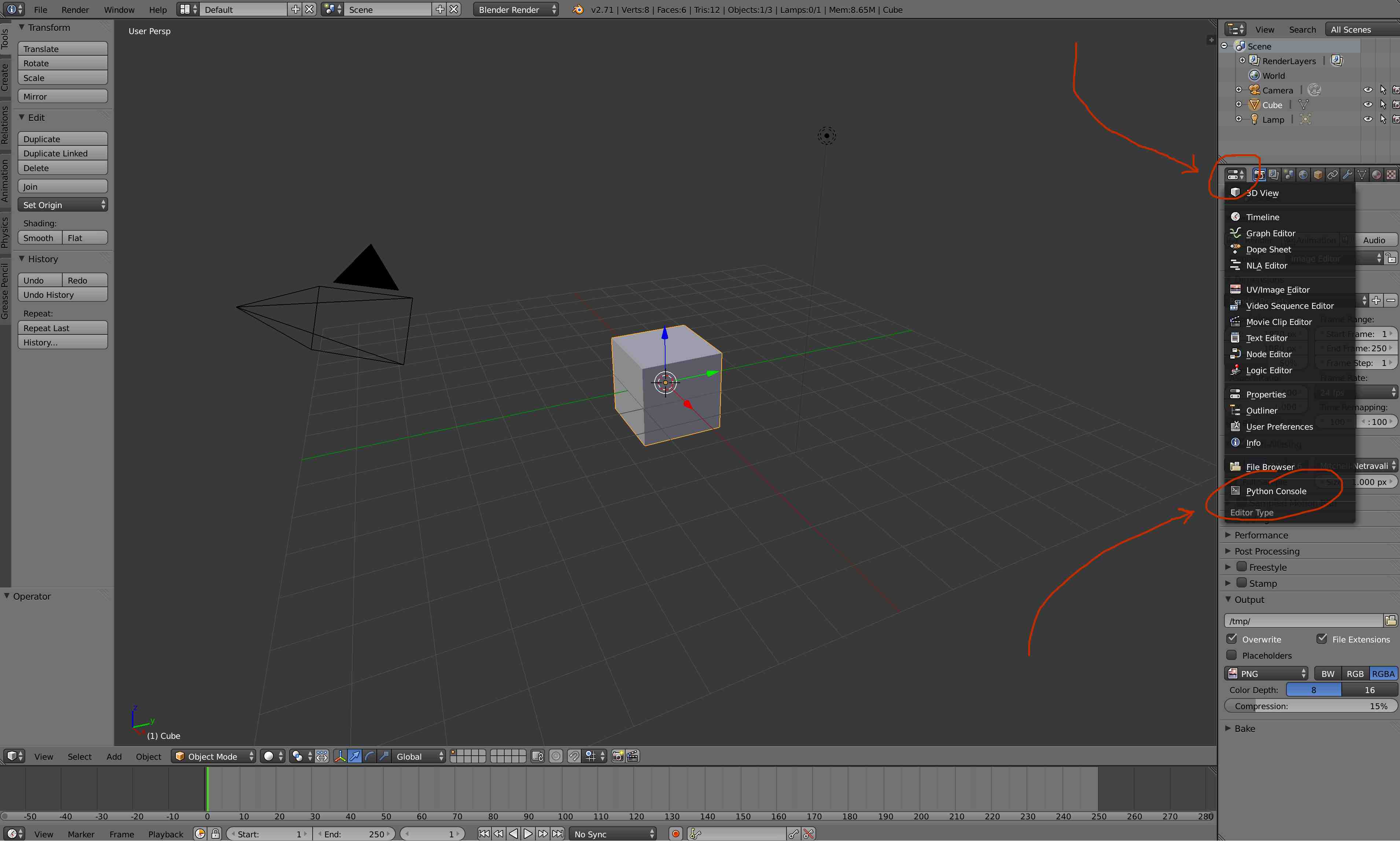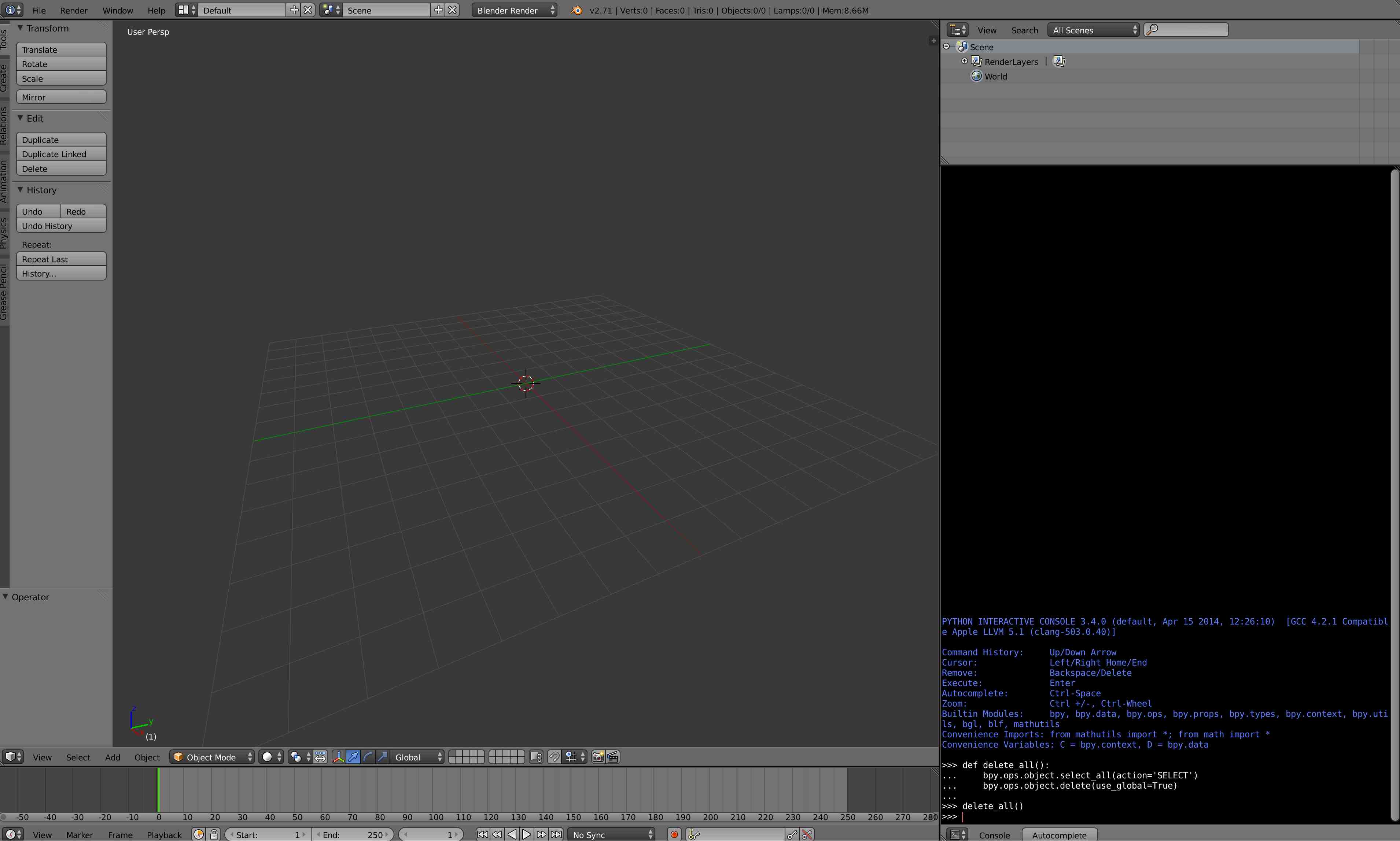I've always wanted to play with 3d images and it now turns out that Blender has a python console that will help you do just that (thanks EuroPython 2014). Blender is an open source 3d editing tool with a sizeable community. It does lack beginner code tutorials with simple examples. Most tutorials are focussed on using the tool by hand because in the end, I imagine that that is how the tool will be used most of the time. My interests are to generate visualisations only based on data and code so in this document I will share some simple, albeit a bit verbose, python code to generate cubes with blender. To keep things simple I will only use cubes. Hopefully this will help get people started with the joy of 3d images.
Set Up with Blender
When you open up blender you can access a python console by clicking on the change editor button and then selecting the python console.

This python console runs python3 and you can veryify that basic python commands work as you would expect. This means that we can define anything function in python here and it would run. We also have access to everything that blender can do through python commands.
Deleting everything
Define the following function;
def delete_all():
bpy.ops.object.select_all(action='SELECT')
bpy.ops.object.delete(use_global=True)
This function will select everything in the scene and then delete everything that is selected. Now everytime you create something you can run delete_all() to remove it. After using this function in the console you should now see an empty scene.

The rest of the document will be python scripts to generate cubes. To show the resulting 3d image I will be using Sketchfab to show what the resulting 3d shape should look like in your blender view.
A Simple Cube
In blender a cube has a location which represents the center of the cube and a radius which describes how large the square is.
bpy.ops.mesh.primitive_cube_add(radius=1, location = (0,0,0))
Cube of Cubes
We can create many cubes in a regular pattern.
numcubes = 6
rcubes = 0.3
for x in range(numcubes):
for y in range(numcubes):
for z in range(numcubes):
bpy.ops.mesh.primitive_cube_add(
radius=rcubes, location = (x,y,z)
)
Cubes of Different Sizes
Note that the radius doubles the size of an arc of a cube. So doubling the radius increase the volume of the cube by a factor of eight.
bpy.ops.mesh.primitive_cube_add(radius=4, location = (0,0,0))
bpy.ops.mesh.primitive_cube_add(radius=3, location = (10,0,0))
bpy.ops.mesh.primitive_cube_add(radius=2, location = (20,0,0))
bpy.ops.mesh.primitive_cube_add(radius=1, location = (30,0,0))
The Sine and Cosine
import math
def f(x,y):
return 5*sin(x/15.0*math.pi) + 5*cos(y/15.0*math.pi)
numcubes = 8
for x in range(-numcubes,numcubes):
for y in range(-numcubes,numcubes):
bpy.ops.mesh.primitive_cube_add(
radius=0.2, location = (x,y,f(x,y))
)
Recursion in all directions
This is my favorite. It shows you how you can make fractal like 3d constructs with only a few lines of python.
def new_cube(old_loc, direction, rad, dimmer):
res = []
for i in [0,1,2]:
res.append(old_loc[i] + direction[i]*dimmer + 2 * direction[i]*rad )
return [rad*dimmer,res]
def rec(cube, depth):
if depth == 4 :
return None
else:
bpy.ops.mesh.primitive_cube_add(
radius=cube[0], location = cube[1]
)
print(cube)
rec( new_cube(cube[1],(1,0,0),cube[0],0.4) , depth + 1 )
rec( new_cube(cube[1],(0,1,0),cube[0],0.4) , depth + 1 )
rec( new_cube(cube[1],(0,0,1),cube[0],0.4) , depth + 1 )
rec( new_cube(cube[1],(-1,0,0),cube[0],0.4) , depth + 1 )
rec( new_cube(cube[1],(0,-1,0),cube[0],0.4) , depth + 1 )
rec( new_cube(cube[1],(0,0,-1),cube[0],0.4) , depth + 1 )
rec([1,(0,0,0)],0)
Random Ant Path
We can simulate a random path that an ant might walk underground. We sample a new cube based on the location of it's previous cube to get a 3d random path. Note that for this to work we need to keep in mind the radius of the previous cube and the new cube.
def randdir():
choices = [(1,0,0),(0,1,0),(0,0,1),(-1,0,0),(0,-1,0),(0,0,-1)]
return random.choice(choices)
def new_cube(old_loc, direction):
res = []
for i in [0,1,2]:
res.append(old_loc[i] + direction[i])
return tuple(res)
cube = (0,0,0)
for i in range(500):
cube = new_cube(cube,randdir())
bpy.ops.mesh.primitive_cube_add(radius=0.5, location = cube)
Normal Distribution
As of this year, you could use numpy but before this wasn't possible. This code was written on a blender version without numpy to show that you can make 3d plots of normal distributions as well.
import random
def r():
return round(random.gauss(0,6))
def bins(s):
minx = min([ i[0] for i in s ])
maxx = max([ i[0] for i in s ])
miny = min([ i[1] for i in s ])
maxy = max([ i[1] for i in s ])
res = {}
for x in range(minx, maxx+1):
xdict = {}
for y in range(miny, maxy+1):
xdict[y] = sum([ 1 for c in s if c[0] == x and c[1] == y ])
res[x] = xdict
return res
bind = bins([ [r(),r()] for i in range(6000) ])
for x in bind.keys():
for y in bind[x].keys():
h = bind[x][y]
if h != 0:
bpy.ops.mesh.primitive_cube_add(
radius=0.5, location = (x,y,h)
)
Conclusion
Blender is a lot of fun. High schools should be jumping on it for educational purposes pronto.